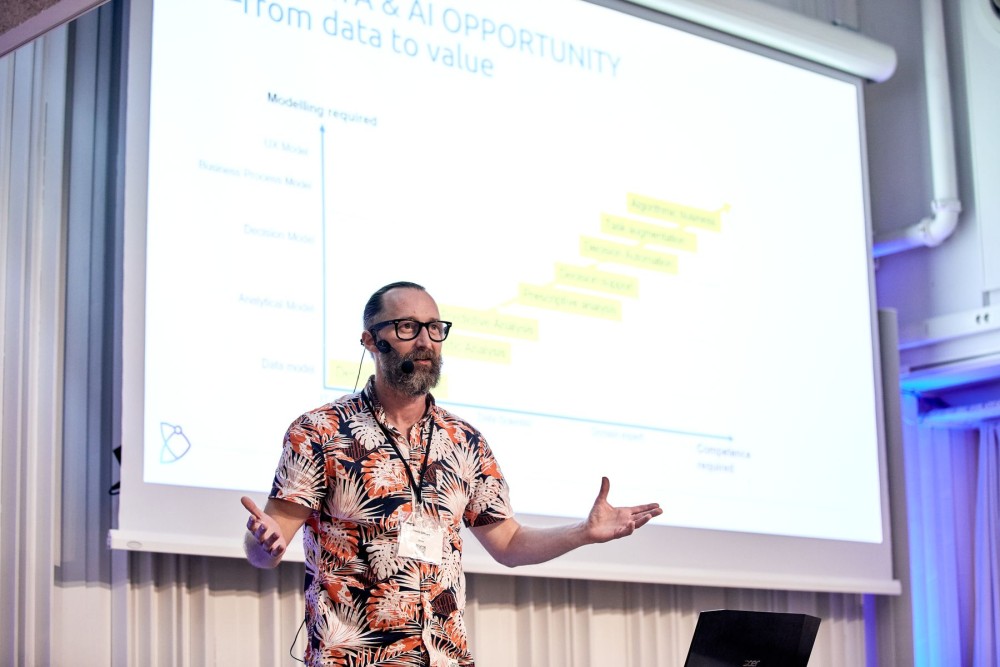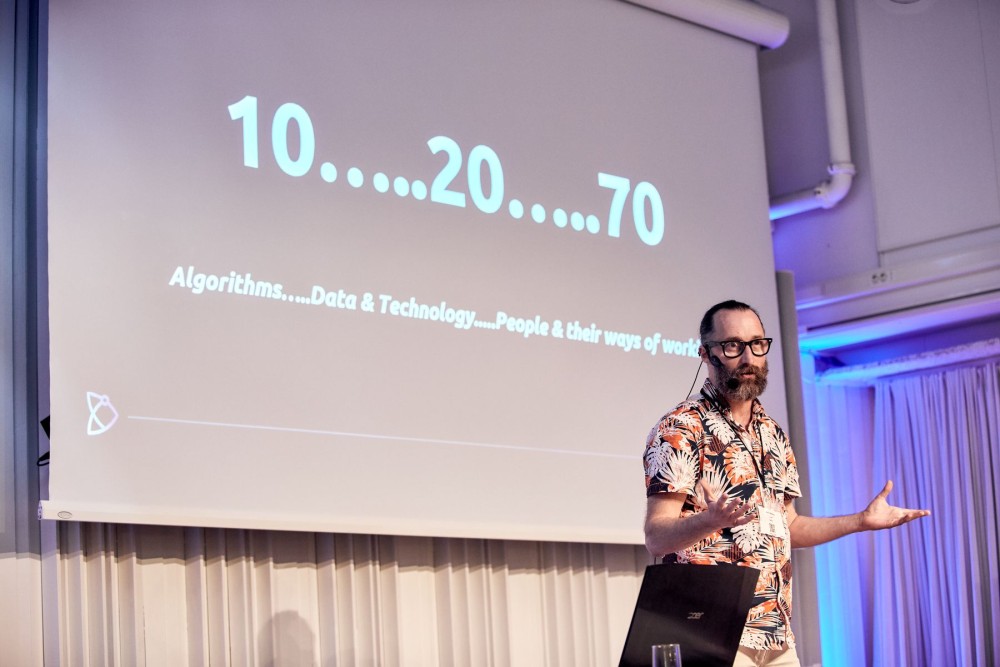Data and AI readiness is the goal of every company looking to succeed in the Data and AI-first society we are living in. To put in more context to the story, we previously talked to Henrik Göthberg, Founder and CEO of DAIRDUX, about the concept of becoming and being Data and AI-ready. As Henrik explained to us in his Data and AI Innovators interview, the Data and AI-Ready – DAIR state at the core means two things:
1) Stop looking at data/AI/Digital from a project/ transformation point of view but rather to organise and operate as an engine or muscle to continuously evolve the organisations frontier of data and AI in their operation.
2) Reaching the state of evolution is about creating a learning organisation by design and stabilising your ways of working, technology, cross-functional teams use of data, etc., for the engine to run smoothly across an enterprise.


But, this time, we are going to look at the people’s perspective and HR’s role in the journey of becoming DAIR (Data and AI-Ready), as well as the role of people in making HR a data and AI-ready function, through Henrik Göthberg’s Nordic People Analytics Summit presentation.
“If HR is not data and AI-ready, and takes ownership of the people perspective of DAIR, how will organisations be relevant to enable the whole company to become Data and AI-ready,” proposed Henrik.
The formula for creating value out of data and AI, analytics or BI, is 10% about algorithms, 20% about data and technology, and as much as 70% about people and their ways of working, like operating procedures, establishing roles, people working in teams, highlights Henrik. This percentage shows the fundamental role of people in data and AI readiness.


The data and AI opportunity
The data and AI opportunity is immense, but still, becoming a data-first organisation is harder, especially for companies with a proud analogue legacy, compared to digital companies. The value of using data and analytics stems from our ability to cross-pollinate our legacy domain expertise and data and AI, claims Henrik.
So in this way, HR must cross-pollinate their domain expertise with data and AI capabilities to find their HR use cases, which are optimising tasks, automating/optimizing tasks, optimizing HR operations, and ultimately reinventing the HR operating model.
The journey from data to value contains several steps for a company to surmount, starting from descriptive analysis and reporting, to decision and task automation, but the data and AI end game is about algorithmic processes and algorithmic business.


Looking at the opportunity from a people perspective, Henrik presented the core capabilities needed to go through the steps.
- IT (Data engineering)
- Data scientist
- Domain expert.
The more a company moves to utilising algorithms to optimise UX, decision and process, the more it needs to involve domain expertise. And the core team working with these projects needs to include domain competence, so the conclusion is the new core people’s perspective is cross-functional, cross-competence teams spanning from engineering to data science, to core business.
The steps from going from data to value are represented in the DIKAR model (based on Venkatraman, 1996) Henrik showcased, which is an acronym for Data turning into Information, turning into Knowledge, turning into Action, turning into Result. As we can conclude, data, information, or knowledge are not the end game – it’s what actions we take and what results we get that counts.
However, the DAIR challenge remains, especially for those companies that are not data-native. Harvard Business Review released an executive summary in 2019, where they state that companies are failing in their efforts to become data-driven. The summary also highlighted that despite increased investment in data and AI across different industries, the general perception among organisations was that they feel less-data driven.
The main mistake that organisations made was they underestimate the criticality and effort of the 70% of the DAIR formula that is about the people, states Henrik.


The paradigm shift
The reason why so many companies faced hurdles on their data and readiness journey is that there is a paradigm shift underway and not just a simple investment. From a company perspective, the shift is three-fold:
- The strategic challenge at an executive level is related to understanding what the business model is all about in a data and AI-first society, establishing what is the fundamental business model and organisation when the company has done the journey of becoming data and AI-ready.
- The middle management challenge is related to transforming the “what should be done” into “how it should be done”; establishing how to steer, govern, execute on the strategy and organizing actions.
- The operational level challenge is related to shifting the processes, establishing team structures, DevOps, operating procedures, technology stacks.
From a strategic level, Henrik emphasises that we are in a macro life cycle shift. What that means is that we are currently undergoing a shift from the industrial era which is focused on efficiency in a mature market place to the data and AI-first era which is about building automation and algorithms into the company’s core processes. It presents, in a way, a reboot of the old, traditional organisation. Organisations are at the stage of reinventing their core processes, and HR processes as well.
The middle management level covers three aspects, according to Henrik. The first one is intersectional innovation which encompasses the data and AI-driven opportunity of living in the intersect between data and AI capability and the domain legacy capability. For HR, the new core would be in the intersect between HR domain expertise and data and AI activities.
The second is perpetual innovation, where our core processes become life cycles and continuous innovation. As more data sets and algorithms are built into a core HR process, the process is changed and reinvented continuously, which also transforms the process ownership to product ownership.
The third aspect is related to the Enterprise DAIR dilemma where on the one hand we solve one specific problem, use case algorithm, data set at a time, but at the same time, we want to start big and have enterprise synergies. The balance is to have the focus on operational use cases, but scale it, so it becomes an enterprise capability, affirm Henrik.


The roadblocks on the journey towards data and AI-ready HR
These are the key roadblocks on the DAIR journey:
- New core literacy – People with domain knowledge should become more data and AI-literate to function in the new core, while data scientists need to gain the domain knowledge.
- Tayloristic leadership – The culture, steering and leadership relying on traditional efficiency and stable processes with separation of responsibilities don’t fit into innovation. The structures need to be redefined, so domain experts, analytics experts and engineering experts work side by side.
- Culture – Transforming the organisation from an efficiency culture to innovation culture that propagates learning, sharing and collaboration.
And HR has an instrumental role in tackling all the above challenges, first in its own department, and later on an enterprise-wide level.


The people perspective of DAIR
In regards to human capital, there are several perspectives where HR should step in to enable people to be DAIR. Henrik outlines several levels of actions that can be taken with human capital on an enterprise, team or individual level, from an operational or strategic perspective:
– On a team level, HR can help embrace new roles and job descriptions like data scientists, data engineer, data analyst, data steward.
– On an individual level, HR should think about training and coaching for data literacy, DAIR leadership, DAIR frameworks and how to conduct them. Traditional team leaders have to go through some learning to transform into server leaders leading agile, autonomous teams.
– From the strategic side, it’s HR’s role to manage new talent, recruit, build a career ladder for new roles like data scientists, and make the new organisational core attractive for these profiles.
– And ultimately, on an enterprise level, HR has a vital role in the change of culture. The culture shift can be done by either replacing quite a lot of people or designing the culture shift around the people by creating a learning organisation, oriented towards sharing and innovation.














Add comment